MONTESSORI PROJECT
|
Click on these dates/links, to see Susan's emails and pictures from her 2008 Bhutan work: Bhutan 2008 — Main page for 2008 trip |
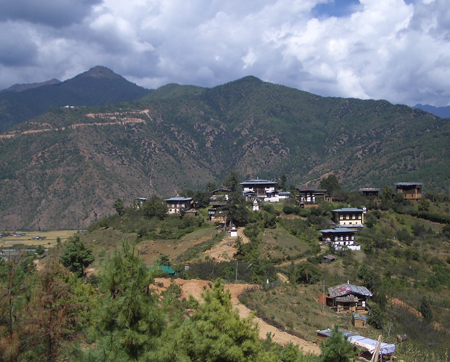 |
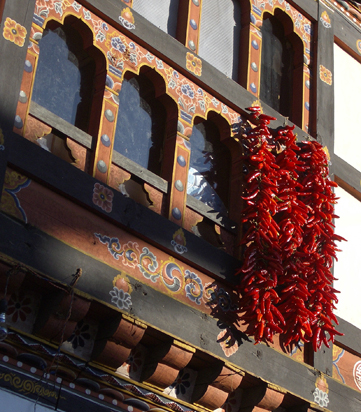 |
A monastery high above the Paro valley, where the family annually hikes in memory of their mother. |
In the fall, hot peppers are drying everywhere to use throughout the winter. |
GOOD MORNING, The 15th of each month is an auspicious (lucky) day. Yesterday, the 15th, is the day that, years ago, Chencho's mother died. Every year the family, four sons and one daughter, have a Buddhist ceremony in her memory. One brother is in Canada so he celebrates there. But the others met here at the house at 8 this morning, packed food (for sure the ubiquitous hot peppers in some form) and butter tea (made of black tea, milk, and salt) and drove, and then walked, to a monastery at the very top of a hill overlooking the Paro valley, where they prayed and remembered her, had a picnic, and enjoyed the beautiful sunny, crisp and cold day high in the Himalayas. They returned at 4 in the afternoon, so happy and wanting to talk about her. I hope my two daughters and son enjoy hearing about this—hint hint. |
Now I will tell you a little more about our Montessori work here. In the Montessori educational field it is said that we must learn all we can about three things. (1) the subject to be taught, (2) the person who is to learn, and (3) the means to put them in touch with each other. This is true whether one is teaching hand-washing, chess, or how to be a Montessori teacher. The education should be based on the needs, the personality, the stage of development of the student. So, since I know a lot about the subject, Montessori, having been in the field since 1970, I am here to focus on the last two—I want to learn all I can about the people and culture of Bhutan, and am constantly thinking about the best way to put the Bhutanese parents and teachers in touch with the bits of Montessori philosophy and practice that they can use, now, and later. I am observing in schools and homes, interviewing parents and grandparents and teachers. I wish I had time and space to tell you everything, but will tell a little about one home visit. |
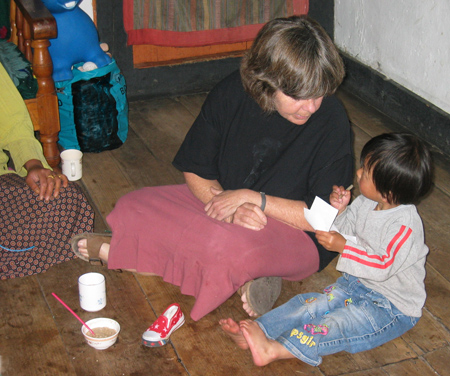 |
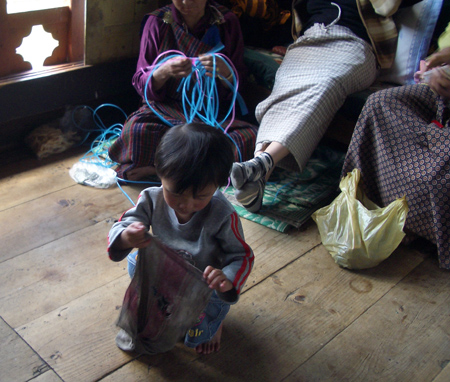 |
Resa interviewing me as I interview her. (Gunilla's photo) |
Resa cleaning the floor. |
OBSERVING RESA Resa is 2.5 and lives in a typical Bhutanese farm house on a working farm in the Paro valley. She is the daughter of Dendy's sister. As I interviewed her mother about her pregnancy, birth, first years of Resa's life, the aunties and grandmother carried on with their life around us. |
Resa was born January 14, 2006. The reason this date is known is that she was born in the hospital which is a new situation in Bhutan. Throughout history people have been born at home and no one really keeps track of the birth date in this kind of situation, which may be why people here don't celebrate birthdays. Just as in Tibet, each year at new year, everyone turns one year older. So it is not easy to figure out the exact age of a child or an adult. |
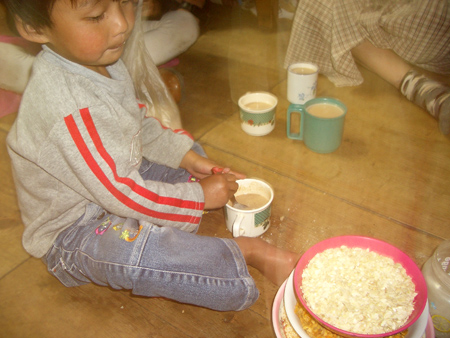 |
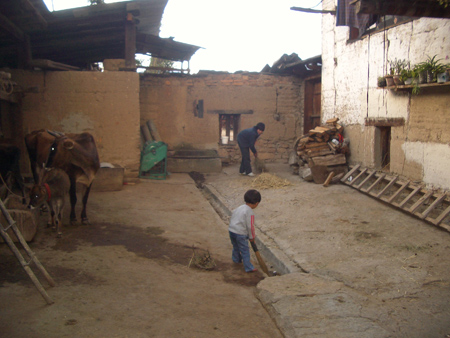 |
Resa fixing her own tsampa. |
Resa sweeping the family courtyard while I interviewed the adults inside. (Gunilla's photo) |
Resa has always had the freedom to go anywhere in the house, joining in with whatever the family was doing at the time. In the early months she was carried by an adult or older sister in a long piece of cloth called a kamney, slung over the back. Or she slept on someone's lap (remember, the houses are not heated), or, if it was warm enough, she was placed on a woven mat or blanket on the floor, in the room where the family was spending time during any part of the day. During my visit some milk was spilled so Resa reached for the cloth her aunt had brought from the kitchen and started cleaning it up. She enjoyed this so much that her older sister poured water on several areas of the floor so Resa could continue cleaning. When we all had tea and tsampa (a grain mixed by each person in their tea and then eaten) Resa prepared her own. She poured her own tea, then took tsampa, as we were doing, and mixed it with her tea to eat. No one paid any special attention to this so it was clear that this was not an uncommon situation. Resa has no toys except a bright, plastic "bike" and one stuffed animal, but her time is spent living life with the adults, joining in whatever they do. |
Before Resa was born the mother, father and older sister all slept in the same bed. After the birth Resa slept at first with just her mother. Many people in the West, hearing about this family bed idea, have tried to imitate it but with a variety of results. In places in Asia I have seen a family bed, the reason for this is lack of space, or warmth, or safety. For example in the countryside of Thailand the family sleep together on a raised wooden platform covered by mosquito netting to be protected from insects and from snakes and other creatures on the ground below them. Family bed in these places is not a temporary situation, but continues throughout life. The problem with trying this in the West, according to Silvana Montanaro, MD and Montessori 0-3 teacher trainer, is that at some point the parents will want their privacy back and the child is bewildered and confused by suddenly being removed from the parents' bed. For some children this rejection can be traumatic. After Resa's birth, as is tradition, the family stayed alone for three days and then a special Buddhist ceremony was performed by visiting monks, complete with horns, cymbals, drums and 2-3 hours of praying. This took place in the family shrine room. After this purification ceremony guests were allowed to come and see the new baby. |
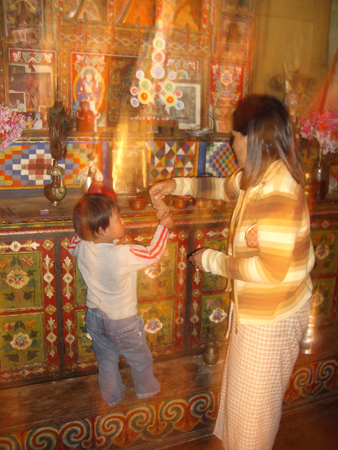 |
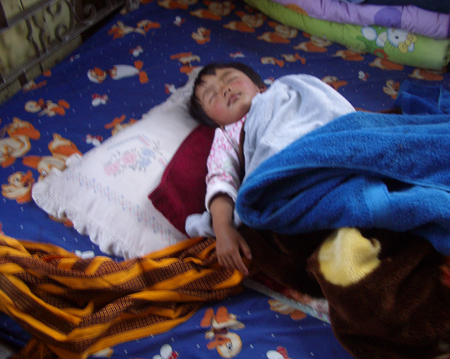 |
Resa making an offering in the family shrine room. (Gunilla's photo) |
Sleeping in the family bed, holding on to the orange baby carrier or kamnay |
After 2-3 months the family took Resa to the local temple to be named. All babies are called "O" until they are given a name. There are only about 50 personal names in Bhutan and most of them are appropriate for either a boy or a girl. At the temple there is a basket of names, each on a separate piece of paper, rolled up. The parent chooses one without looking and that is the child's name. The rooms of the house are separated from each other by a door, and the door jam is very tall, the top about 6-12 inches from the floor. The reason for this is that in the past people believed that there might be a ghost in the house, called a day. Such a visiting spirit of the dead cannot get over the tall door jams. The ghosts are in the shape of a human but they do not lift their feet when they walk, but rather they shuffle, so they are restricted to one room. In any case this door jam is good for a child who is learning to crawl and needs both safety and freedom to move about. |
Our interview went on for several hours and during that time Resa went outside for awhile and swept the courtyard. When it was time to leave Dendy, as always, went into the family shrine to pray for a few minutes, and to leave a small gift of money on the alter. Resa went with her and reached out her hand for the money in order to be the one to place the gift on the alter. It was such a joy to see a 2-year-old carry out the day in this way, being allowed to naturally join in in all the activities of the family. I am sure that had there been a lot of toys, it would have been a shame. It was so nice to be able to tell Resa's mother, aunties, grandmother, that many of the Bhutanese traditions, as far as the early life of children, are in accord with that we try to teach parents in Montessori 0-3 courses at home: early privacy and bonding, following the child, supporting independence, inviting them to share the daily life of the family. I want to help the Bhutanese people appreciate the value of what they already do, so they will not discard these practices as they join the modern world, and modern education. |
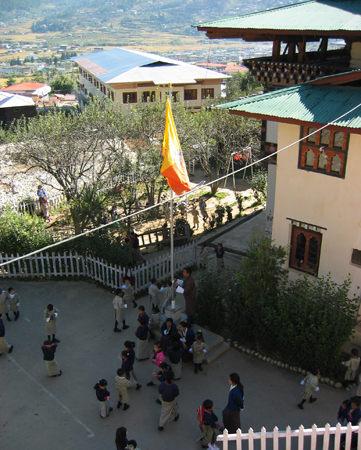 |
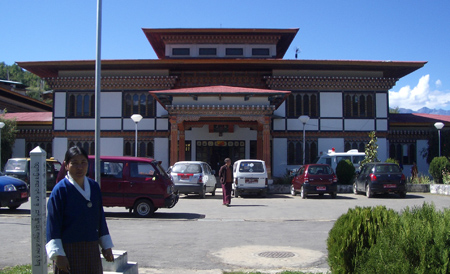 |
The school, on the right in a traditional house. In the background the new school being built. |
The hospital in Paro, for both Bhutanese and Western medicine. Both free to all. |
THE SCHOOL Aside from working to share Montessori 0-3 information, I have given one talk so far to the teachers of children from ages 3-12, explaining aspects of Montessori they can use right now. What I find myself coming back to, no matter where we start, are the values of real work, and respecting concentration. Dendy and Chencho started their school in 2003. Both were previously teachers. Chencho was a teacher in the school attended by the King of Bhutan, in Thimphu. He is very kind and humble and funny, and of course intelligent. Dendy is a natural teacher, really wonderful. They started their school with 20+ children and now have 200. This is one of the best schools I have seen, and in February Dendy will begin to teach the first authentic 3-6 Montessori class. In the meantime they are sharing Montessori ideas with all of the teachers at all levels, and agree with me that it is important for parents to understand and use the Montessori 0-3 ideas in the home, and that the teachers of older children also learn and appreciate this different method of education. Okay, enough about education. THE HOSPITAL Yesterday Gunilla and I visited the hospital. It is half Western Medicine (excellent for surgery, broken bones, infections, etc.) and half traditional Bhutanese medicine (excellent for chronic conditions like arthritis, diabetes, cancer, etc.) The diagnosis is carried out by feeling the pulse on both wrists (many many more pulses than you or I could feel) and by looking at the tongue and eyes (and sometimes a urine sample). We were both checked out by the doctor who is one of the parents at Dendy's school. Bhutan has several names, one of them in Tibetan means "the place to the south where the medicinal plants grow", although I have been treated by traditional doctors in China, Tibet, Nepal, and India, and it is very special to have a check-up here, where the medicinal herbs actually grow. |
Gunilla received a week of medicine for two conditions she has been taking medicine for for a long time. I was declared in perfect health. (Aside, Gunilla was completely out of pain and without her other symptoms in a week, after years of suffering, and is taking the medicine back in Thailand for a month). THE SNAKES And now a true story to end this email: The only airport in this country is in Paro. Thimphu is the capital. The road between these two towns used to take 2 hours. Now, because of road building it takes 45 minutes. While traveling on this new highway one comes to a place where the road narrows to one lane and is surrounded by a string of prayer flags. Here is the reason for this situation: When the road was being built, one day it was time to dynamite a giant bolder on the cliff to make room for the second lane. But two large snakes appeared on the road. Animals are not killed in this Buddhist country except when they are needed for food, so many attempts were made to lure the snakes away with good food and prayer. The snakes would not leave. Monks were brought in to perform pujas, or religious ceremonies, to try to get the snakes to leave. They would not leave. Finally the King was approached for advice on what to do. He said that the snakes must be respected and that part of the road would just have to be narrow. He said that hurting the snakes could bring harm to people driving on that part of the road in the future. So the road-building continued. Then the snakes left! Soon after this the workers discovered a nest of baby snakes nearby, and everyone was so glad they had not killed the parents. To this day prayer flags are kept there always as a reminder of compassion for all living things. LOVE, |
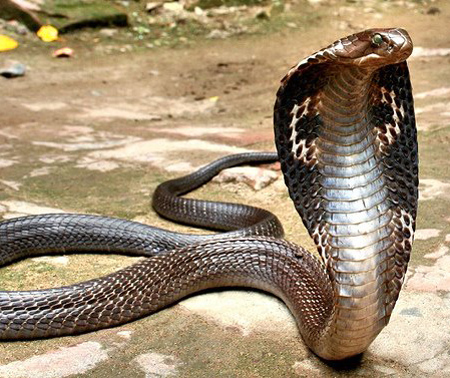 |
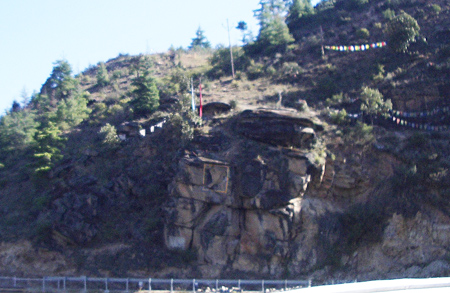 |
(I did not take this photo) This is an Indian Cobra. I could not find out what kind of snake interrupted the road-building, but this one exists at this altitude in Bhutan and just might be the one. |
Prayer flags above the narrow part of the Paro-Thimphu road. |
Return to the Bhutan Montessori Project home page — Bhutan, 2006
Return to Michael Olaf Children's Projects — Projects |
|